
Lycopodium clavatum is the most widespread species in the genus Lycopodium in the clubmoss family.

Amaranthus hypochondriacus is an ornamental plant commonly known as Prince-of-Wales feather or prince's-feather. Originally endemic to Mexico, it is called quelite, bledo and quintonil in Spanish.

Alisma lanceolatum is a species of aquatic plant in the water plantain family known by the common names lanceleaf water plantain and narrow-leaved water plantain. It is widespread across Europe, North Africa and temperate Asia. It is naturalized in Australia, New Zealand, Oregon, California and British Columbia. It is considered a noxious weed in some places.

Alopecurus aequalis is a common species of grass known as shortawn foxtail or orange foxtail. It is native to much of the temperate Northern Hemisphere from Eurasia to North America. It is most commonly found in areas near fresh water, such as the margins of ponds and ditches.
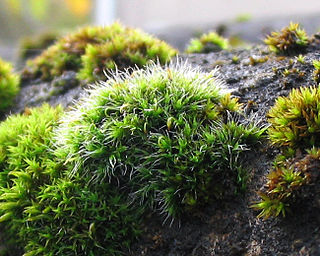
Grimmia pulvinata, otherwise known as grey-cushioned grimmia or pulvinate dry rock moss, is a bryophyte moss common in temperate climates worldwide.
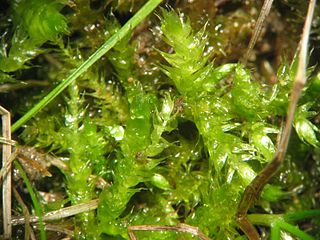
Brachytheciaceae is a family of mosses from the order Hypnales. The family includes over 40 genera and 250 species.

Andreaea rothii, or Roth's andreaea moss, is a species of moss in the family Andreaeaceae native to North America and parts of Europe. This plant was described in 1807 by Weber and Mohr.

Plagiomnium venustum, also known as magnificent leafy moss, is a species of moss belonging to the family Mniaceae. It is found mainly in western North America along the coastal region. This moss can be identified from other members of the Plagiomnium genus by dark coloured stomata guide cells and the absence of sterile stems. It is most commonly found growing as a mat on a variety of substrate, but mainly on humus and moist soil.

Andreaea rupestris is a species of moss in the class Andreaeopsida, are commonly referred to as the "lantern mosses" due to the appearance of their dehisced sporangia. It is typically found on smooth, acidic, exposed rock in the Northern hemisphere. It exhibits the common features of the genus Andreaea such as being acrocarpous, having dark pigmentation, lacking a seta, and bearing 4 lines of dehiscence in its mature sporangia, but can be further identified upon careful examination of its gametophytic leaves which have an ovate base to a more blunt apex compared to other similar species.

Kindbergia is a genus of mosses belonging to the family Brachytheciaceae.
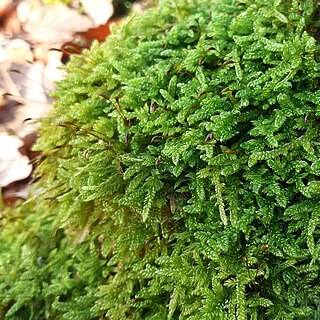
Hypnum is a genus of mosses belonging to the family Hypnaceae.
Bryocrumia vivicolor is a rheophytic species of moss belonging to the family Hypnaceae, and is the sole representative of the genus Bryocrumia.
Crumia latifolia is a species of moss belonging to the family Pottiaceae, and is the sole representative of the genus Crumia.
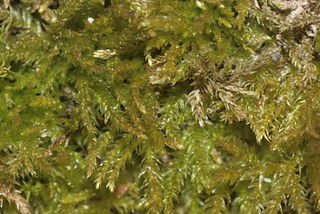
Eurhynchiastrum pulchellum is a species of mosses belonging to the family Brachytheciaceae. It is the sole species of the genus Eurhynchiastrum.

Ulota crispa, the crisped pincushion moss, is a species of acrocarpous moss in the genus Ulota native to eastern North America. It is generally found in tight mounds on tree bark.

Polytrichum piliferum, the bristly haircap, is an evergreen perennial species of moss in the family Polytrichaceae. The bristly haircap moss is small-sized to medium-sized and forms loose tufts with wine-reddish stems. It is an acrocarpous moss that appears bluish-green to grey. This moss grows in clumps on erect shoots and becomes a red-brown colour as it grows older. The most distinguishing feature of P. piliferum is the long, white awn at the tips of the leaves, which also give this moss its grey colour. It is the only species in its genus where the awn is completely hyaline.
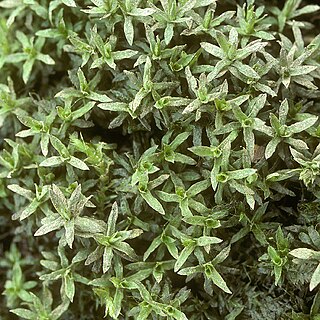
Timmia megapolitana, also known as Indian feather moss and warrior moss is a genus of moss in the family Timmiaceae and order Timmiales.

Sphagnum contortum is a species of moss reported in North America and Europe. NatureServe marked its global conservation status as Secure.
Atrichum crispum is a species of moss. It is dioicous with males being the same size as females or larger.
















